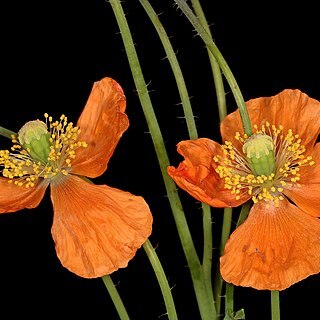Annual herb, 0.1-1.0 m high, from taproots, glaucous, hairy, bristly or spiny; sap milky or coloured. Leaves rosulate, dentate or crenate, pinnately incised, ± spiny, petiolate. Flowers solitary or cymose on elongated peduncles; bracteate; buds drooping. Sepals 2, distinct, mostly caducous. Petals broadly obovate, salmon-pink or orange-red. Ovary with parietal placentas, clavate, bristly; ovules many; style absent; stigmas arranged in conical to flat disc over placentas, velvety. Flowering time Sept.-Feb. Fruit a capsule, clavate in outline, opening by 3-18 pores. Seeds many, small, often reniform, with sculptured testa.
Erect, annual herb, up to 0.9 m high. Leaves with blade, bluish green, shallowly to deeply pinnately lobed, dentations with apical yellowish spines, midrib and veins densely spiny beneath, up to 250 x 60 mm. Flowers: peduncles drooping; corolla, ± 40 mm in diameter, petals fall off quickly, salmon-pink or orange-red; Nov.-Jan. Fruit a capsule opening by pores, glabrous.
A herb. It grows each year from seed. It grows about 1 m tall. The stems are branched, angled and prickly. The leaves are in a ring at the base. They are divided into lobes along the stalk. The flowers are orange. The fruit is an oval poppy seed head. It has ribs.
Erect annual herb, up to 0.9 m high. Leaves shallowly to deeply pinnately lobed, dentations with apical yellowish spines, midrib and veins densely spiny beneath. Fruit a capsule, opening by pores. Flowers salmon-pink or orange-red.
Erect, tufted annual to 1 m, peduncles spreading-prickly. Leaves pinnatifid, toothed and prickly. Flowers pedunculate, orange, 20-40 mm diam. Capsule glabrous, terminal disc ± 8-rayed.

